KIA FORTE KOUP 2018 Owners Manual
Manufacturer: KIA, Model Year: 2018, Model line: FORTE KOUP, Model: KIA FORTE KOUP 2018Pages: 584, PDF Size: 15.16 MB
Page 341 of 584
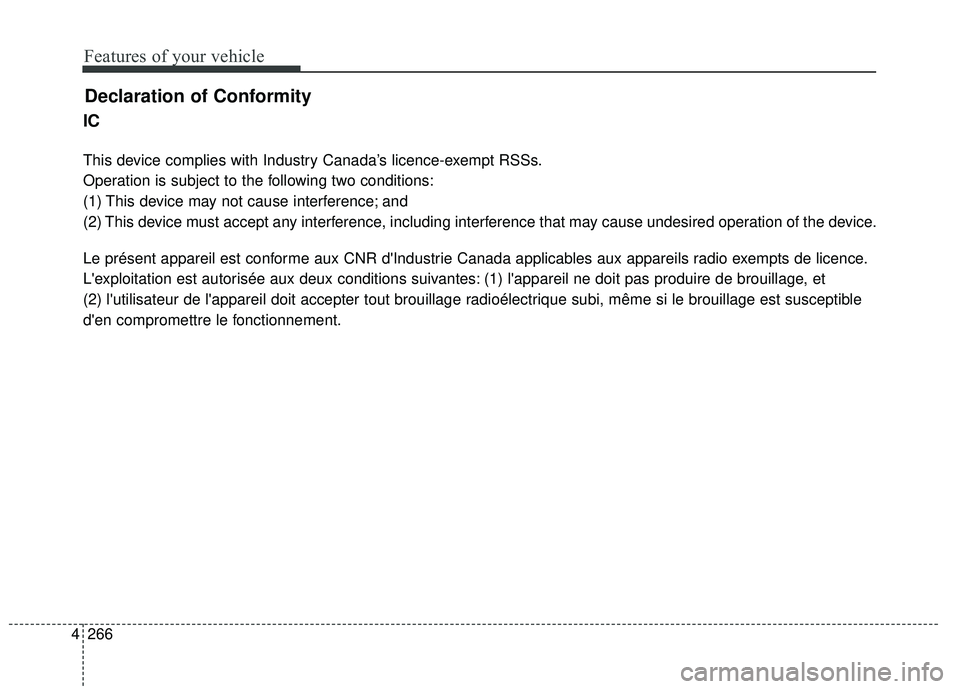
4 266
Declaration of Conformity
IC
This device complies with Industry Canada’s licence-exempt RSSs.
Operation is subject to the following two conditions:
(1) This device may not cause interference; and
(2) This device must accept any interference, including interference that may cause undesired operation of the device.
Le présent appareil est conforme aux CNR d'Industrie Canada applicables aux appareils radio exempts de licence.
L'exploitation est autorisée aux deux conditions suivantes: (1) l'appareil ne doit pas produire de brouillage, et
(2) l'utilisateur de l'appareil doit accepter tout brouillage radioélectrique subi, même si le brouillage est susceptible
d'en compromettre le fonctionnement.
Features of your vehicle
Page 342 of 584

Driving your vehicle
Before driving . . . . . . . . . . . . . . . . . . . . . . . . . . . . . . 5-4
• Before entering vehicle . . . . . . . . . . . . . . . . . . . . . . . . . 5-4
• Necessary inspections . . . . . . . . . . . . . . . . . . . . . . . . . . 5-4
• Before starting . . . . . . . . . . . . . . . . . . . . . . . . . . . . . . . . 5-4
key positions . . . . . . . . . . . . . . . . . . . . . . . . . . . . . . . 5-6
• Illuminated ignition switch . . . . . . . . . . . . . . . . . . . . . . 5-6
• Ignition switch position . . . . . . . . . . . . . . . . . . . . . . . . . 5-6
Engine start/stop button . . . . . . . . . . . . . . . . . . . . . 5-8
• Illuminated ENGINE START/STOP button . . . . . . . 5-8
• ENGINE START/STOP button position . . . . . . . . . . . 5-8
Starting the engine . . . . . . . . . . . . . . . . . . . . . . . . . 5-11
• Starting the engine with an ignition key . . . . . . . . . . 5-11
• Starting the engine with a smart key. . . . . . . . . . . . . 5-12
Manual Transaxle. . . . . . . . . . . . . . . . . . . . . . . . . . 5-14
• Manual transaxle operation . . . . . . . . . . . . . . . . . . . . 5-14
• Good driving practices . . . . . . . . . . . . . . . . . . . . . . . . 5-17
Automatic transaxle . . . . . . . . . . . . . . . . . . . . . . . . 5-18
• Automatic transaxle operation. . . . . . . . . . . . . . . . . . 5-18
• Good driving practices . . . . . . . . . . . . . . . . . . . . . . . . 5-23
Dual Clutch Transmission (DCT) . . . . . . . . . . . . . 5-24
• Dual clutch transmission operation . . . . . . . . . . . . . 5-24
• Paddle shifter . . . . . . . . . . . . . . . . . . . . . . . . . . . . . . . . 5-30
• Good driving practices . . . . . . . . . . . . . . . . . . . . . . . . 5-32
Brake system . . . . . . . . . . . . . . . . . . . . . . . . . . . . . . 5-34
• Power brakes . . . . . . . . . . . . . . . . . . . . . . . . . . . . . . . . 5-34
• Parking brake . . . . . . . . . . . . . . . . . . . . . . . . . . . . . . . 5-35
• Anti-lock brake system (ABS) . . . . . . . . . . . . . . . . . . 5-37
• Electronic stability control (ESC) . . . . . . . . . . . . . . . 5-39
• Hill-start assist control (HAC) . . . . . . . . . . . . . . . . . . 5-43
• Vehicle stability management (VSM) . . . . . . . . . . . . 5-43
• Good braking practices. . . . . . . . . . . . . . . . . . . . . . . . 5-45
Autonomous emergency braking (AEB)/Forward collision warning (FCW) . . . . . . . . . . . 5-47
• System setting and activation . . . . . . . . . . . . . . . . . . . 5-47
• AEB warning message and system control . . . . . . . . 5-49
• Brake operation . . . . . . . . . . . . . . . . . . . . . . . . . . . . . . 5-50
• Sensor to detect the distance from the vehicle in
front (front radar) . . . . . . . . . . . . . . . . . . . . . . . . . . . 5-51
• System malfunction . . . . . . . . . . . . . . . . . . . . . . . . . . . 5-52
• Limitation of the system . . . . . . . . . . . . . . . . . . . . . . . 5-53
• Recognizing pedestrians . . . . . . . . . . . . . . . . . . . . . . . 5-56
Cruise Control system . . . . . . . . . . . . . . . . . . . . . . 5-58
• Cruise control switch . . . . . . . . . . . . . . . . . . . . . . . . . 5-58
• To set cruise control speed: . . . . . . . . . . . . . . . . . . . . 5-59
• To increase cruise control set speed: . . . . . . . . . . . . . 5-60
• To decrease the cruising speed: . . . . . . . . . . . . . . . . . 5-60
• To temporarily accelerate with the cruise control on . . 5-60
• To cancel cruise control . . . . . . . . . . . . . . . . . . . . . . . 5-61
5
Page 343 of 584
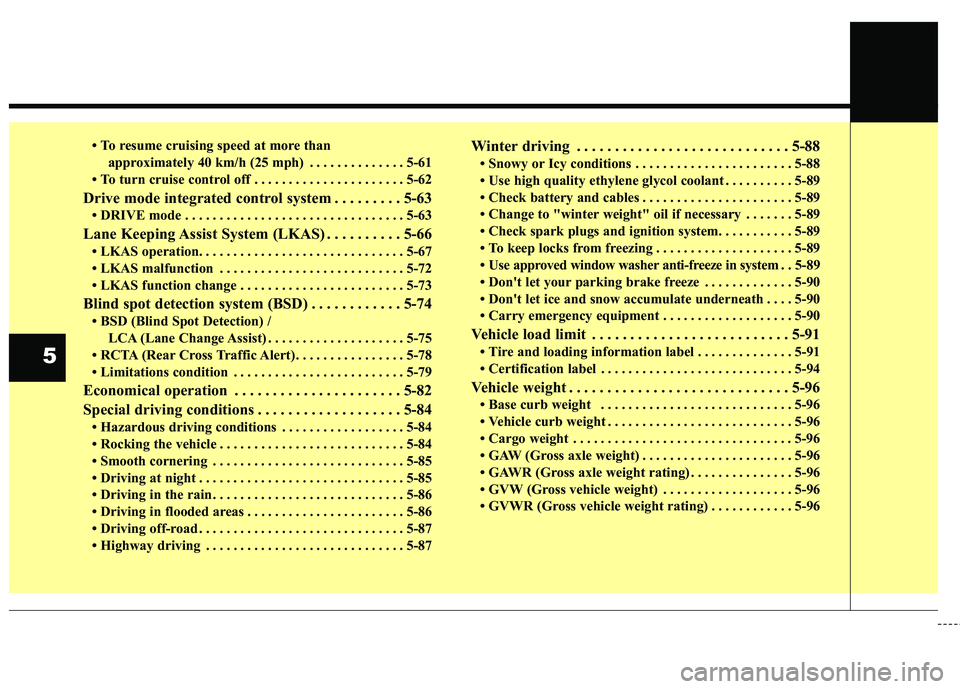
• To resume cruising speed at more thanapproximately 40 km/h (25 mph) . . . . . . . . . . . . . . 5-61
• To turn cruise control off . . . . . . . . . . . . . . . . . . . . . . 5-62
Drive mode integrated control system . . . . . . . . . 5-63
• DRIVE mode . . . . . . . . . . . . . . . . . . . . . . . . . . . . . . . . 5-63
Lane Keeping Assist System (LKAS) . . . . . . . . . . 5-66
• LKAS operation. . . . . . . . . . . . . . . . . . . . . . . . . . . . . . 5-6\
7
• LKAS malfunction . . . . . . . . . . . . . . . . . . . . . . . . . . . 5-72
• LKAS function change . . . . . . . . . . . . . . . . . . . . . . . . 5-73
Blind spot detection system (BSD) . . . . . . . . . . . . 5-74
• BSD (Blind Spot Detection) / LCA (Lane Change Assist) . . . . . . . . . . . . . . . . . . . . 5-75
• RCTA (Rear Cross Traffic Alert) . . . . . . . . . . . . . . . . 5-78
• Limitations condition . . . . . . . . . . . . . . . . . . . . . . . . . 5-79
Economical operation . . . . . . . . . . . . . . . . . . . . . . 5-82
Special driving conditions . . . . . . . . . . . . . . . . . . . 5-84
• Hazardous driving conditions . . . . . . . . . . . . . . . . . . 5-84
• Rocking the vehicle . . . . . . . . . . . . . . . . . . . . . . . . . . . 5-84
• Smooth cornering . . . . . . . . . . . . . . . . . . . . . . . . . . . . 5-85
• Driving at night . . . . . . . . . . . . . . . . . . . . . . . . . . . . . . 5-85
• Driving in the rain . . . . . . . . . . . . . . . . . . . . . . . . . . . . 5-86
• Driving in flooded areas . . . . . . . . . . . . . . . . . . . . . . . 5-86
• Driving off-road . . . . . . . . . . . . . . . . . . . . . . . . . . . . . . 5-87
• Highway driving . . . . . . . . . . . . . . . . . . . . . . . . . . . . . 5-87
Winter driving . . . . . . . . . . . . . . . . . . . . . . . . . . . . 5-88
• Snowy or Icy conditions . . . . . . . . . . . . . . . . . . . . . . . 5-88
• Use high quality ethylene glycol coolant . . . . . . . . . . 5-89
• Check battery and cables . . . . . . . . . . . . . . . . . . . . . . 5-89
• Change to "winter weight" oil if necessary . . . . . . . 5-89
• Check spark plugs and ignition system. . . . . . . . . . . 5-89
• To keep locks from freezing . . . . . . . . . . . . . . . . . . . . 5-89
• Use approved window washer anti-freeze in system . . 5-89
• Don't let your parking brake freeze . . . . . . . . . . . . . 5-90
• Don't let ice and snow accumulate underneath . . . . 5-90
• Carry emergency equipment . . . . . . . . . . . . . . . . . . . 5-90
Vehicle load limit . . . . . . . . . . . . . . . . . . . . . . . . . . 5-91
• Tire and loading information label . . . . . . . . . . . . . . 5-91
• Certification label . . . . . . . . . . . . . . . . . . . . . . . . . . . . 5-94
Vehicle weight . . . . . . . . . . . . . . . . . . . . . . . . . . . . . 5-96
• Base curb weight . . . . . . . . . . . . . . . . . . . . . . . . . . . . 5-96
• Vehicle curb weight . . . . . . . . . . . . . . . . . . . . . . . . . . . 5-96
• Cargo weight . . . . . . . . . . . . . . . . . . . . . . . . . . . . . . . . 5-96
• GAW (Gross axle weight) . . . . . . . . . . . . . . . . . . . . . . 5-96
• GAWR (Gross axle weight rating) . . . . . . . . . . . . . . . 5-96
• GVW (Gross vehicle weight) . . . . . . . . . . . . . . . . . . . 5-96
• GVWR (Gross vehicle weight rating) . . . . . . . . . . . . 5-96
5
Page 344 of 584
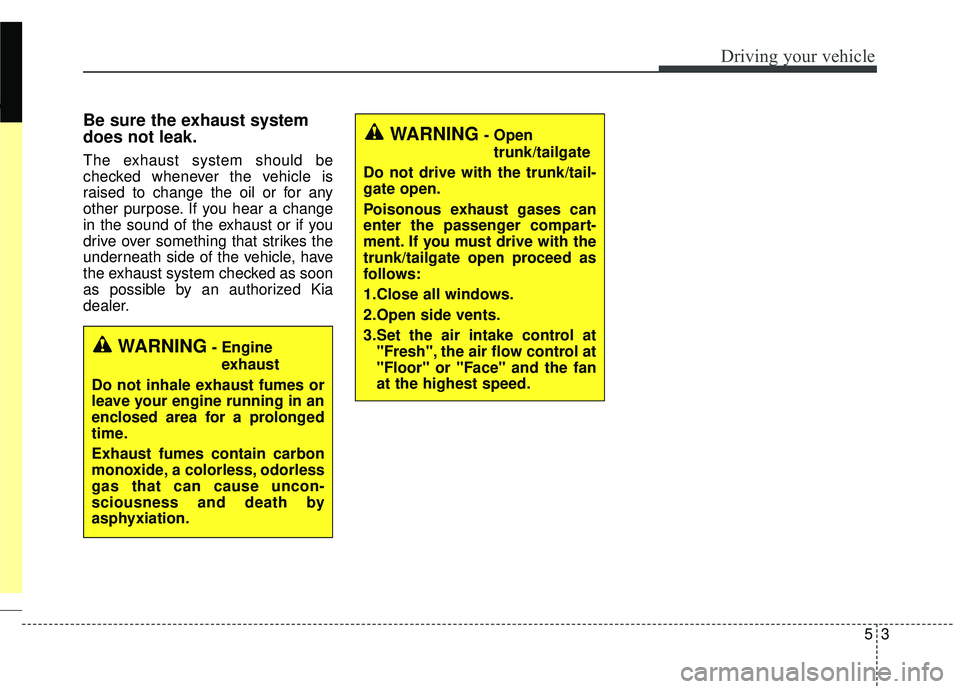
53
Driving your vehicle
Be sure the exhaust system
does not leak.
The exhaust system should be
checked whenever the vehicle is
raised to change the oil or for any
other purpose. If you hear a change
in the sound of the exhaust or if you
drive over something that strikes the
underneath side of the vehicle, have
the exhaust system checked as soon
as possible by an authorized Kia
dealer.
WARNING- Engineexhaust
Do not inhale exhaust fumes or
leave your engine running in an
enclosed area for a prolonged
time.
Exhaust fumes contain carbon
monoxide, a colorless, odorless
gas that can cause uncon-
sciousness and death by
asphyxiation.
WARNING- Open trunk/tailgate
Do not drive with the trunk/tail-
gate open.
Poisonous exhaust gases can
enter the passenger compart-
ment. If you must drive with the
trunk/tailgate open proceed as
follows:
1.Close all windows.
2.Open side vents.
3.Set the air intake control at "Fresh", the air flow control at
"Floor" or "Face" and the fan
at the highest speed.
Page 345 of 584
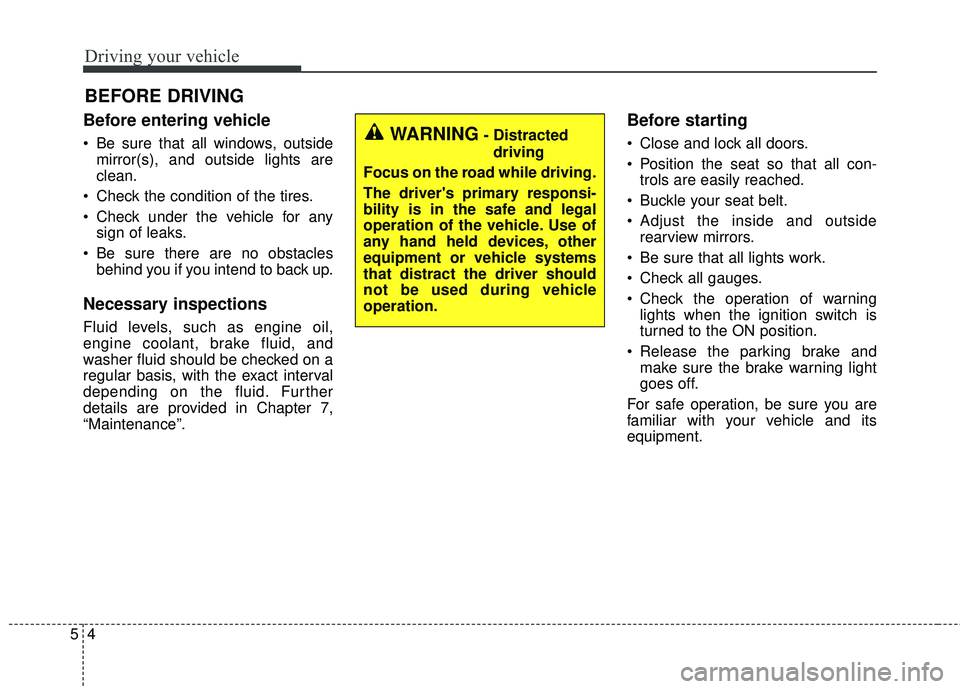
Driving your vehicle
45
Before entering vehicle
• Be sure that all windows, outsidemirror(s), and outside lights are
clean.
Check the condition of the tires.
Check under the vehicle for any sign of leaks.
Be sure there are no obstacles behind you if you intend to back up.
Necessary inspections
Fluid levels, such as engine oil,
engine coolant, brake fluid, and
washer fluid should be checked on a
regular basis, with the exact interval
depending on the fluid. Further
details are provided in Chapter 7,
“Maintenance”.
Before starting
Close and lock all doors.
Position the seat so that all con-trols are easily reached.
Buckle your seat belt.
Adjust the inside and outside rearview mirrors.
Be sure that all lights work.
Check all gauges.
Check the operation of warning lights when the ignition switch is
turned to the ON position.
Release the parking brake and make sure the brake warning light
goes off.
For safe operation, be sure you are
familiar with your vehicle and its
equipment.
BEFORE DRIVING
WARNING- Distracted driving
Focus on the road while driving.
The driver's primary responsi-
bility is in the safe and legal
operation of the vehicle. Use of
any hand held devices, other
equipment or vehicle systems
that distract the driver should
not be used during vehicle
operation.
Page 346 of 584
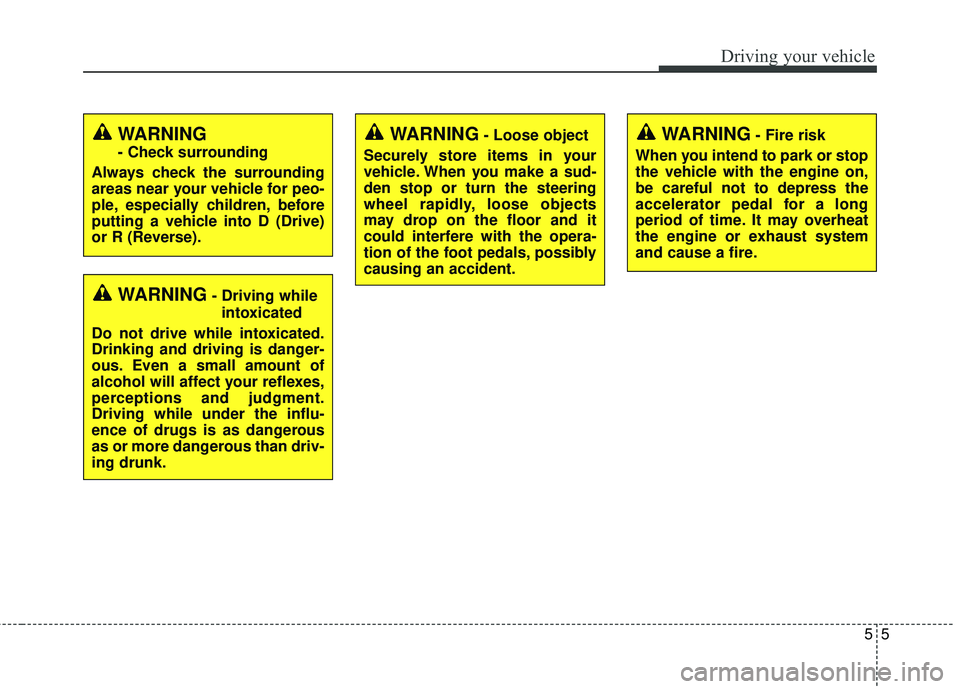
55
Driving your vehicle
WARNING- Fire risk
When you intend to park or stop
the vehicle with the engine on,
be careful not to depress the
accelerator pedal for a long
period of time. It may overheat
the engine or exhaust system
and cause a fire.
WARNING- Driving while intoxicated
Do not drive while intoxicated.
Drinking and driving is danger-
ous. Even a small amount of
alcohol will affect your reflexes,
perceptions and judgment.
Driving while under the influ-
ence of drugs is as dangerous
as or more dangerous than driv-
ing drunk.
WARNING- Loose object
Securely store items in your
vehicle. When you make a sud-
den stop or turn the steering
wheel rapidly, loose objects
may drop on the floor and it
could interfere with the opera-
tion of the foot pedals, possibly
causing an accident.WARNING
- Check surrounding
Always check the surrounding
areas near your vehicle for peo-
ple, especially children, before
putting a vehicle into D (Drive)
or R (Reverse).
Page 347 of 584
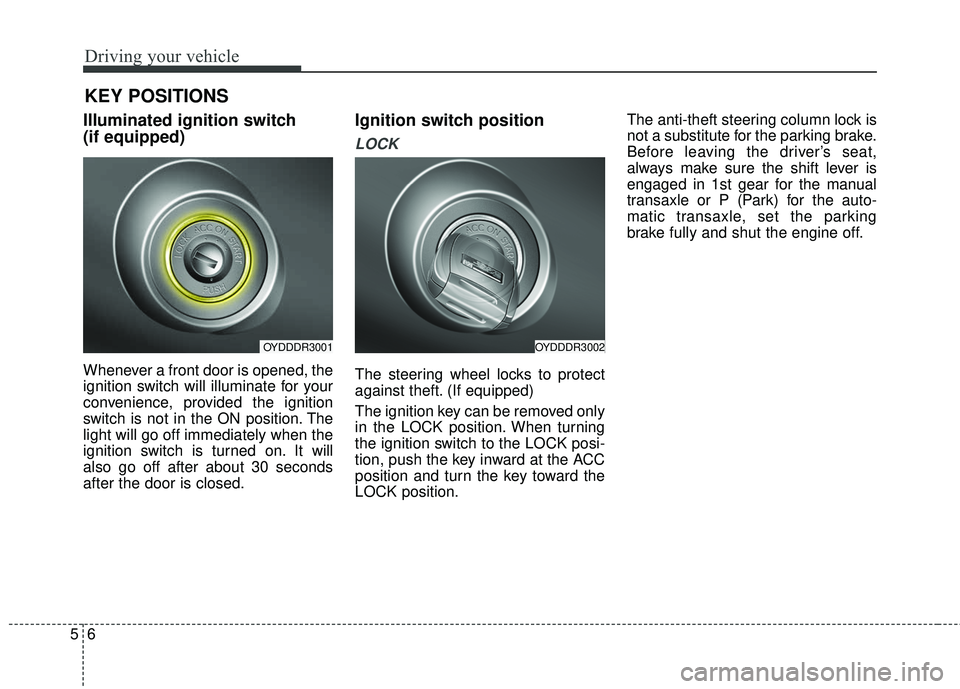
Driving your vehicle
65
Illuminated ignition switch
(if equipped)
Whenever a front door is opened, the
ignition switch will illuminate for your
convenience, provided the ignition
switch is not in the ON position. The
light will go off immediately when the
ignition switch is turned on. It will
also go off after about 30 seconds
after the door is closed.
Ignition switch position
LOCK
The steering wheel locks to protect
against theft. (If equipped)
The ignition key can be removed only
in the LOCK position. When turning
the ignition switch to the LOCK posi-
tion, push the key inward at the ACC
position and turn the key toward the
LOCK position.The anti-theft steering column lock is
not a substitute for the parking brake.
Before leaving the driver’s seat,
always make sure the shift lever is
engaged in 1st gear for the manual
transaxle or P (Park) for the auto-
matic transaxle, set the parking
brake fully and shut the engine off.
KEY POSITIONS
OYDDDR3001OYDDDR3002
Page 348 of 584
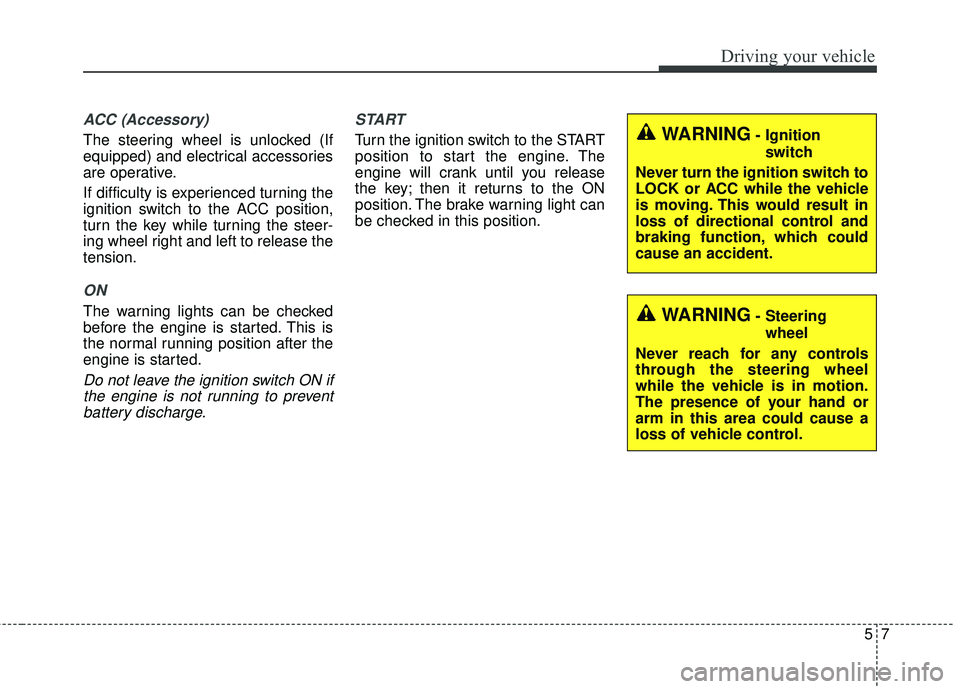
57
Driving your vehicle
ACC (Accessory)
The steering wheel is unlocked (If
equipped) and electrical accessories
are operative.
If difficulty is experienced turning the
ignition switch to the ACC position,
turn the key while turning the steer-
ing wheel right and left to release the
tension.
ON
The warning lights can be checked
before the engine is started. This is
the normal running position after the
engine is started.
Do not leave the ignition switch ON ifthe engine is not running to preventbattery discharge. START
Turn the ignition switch to the START
position to start the engine. The
engine will crank until you release
the key; then it returns to the ON
position. The brake warning light can
be checked in this position.WARNING- Ignition
switch
Never turn the ignition switch to
LOCK or ACC while the vehicle
is moving. This would result in
loss of directional control and
braking function, which could
cause an accident.
WARNING- Steering wheel
Never reach for any controls
through the steering wheel
while the vehicle is in motion.
The presence of your hand or
arm in this area could cause a
loss of vehicle control.
Page 349 of 584
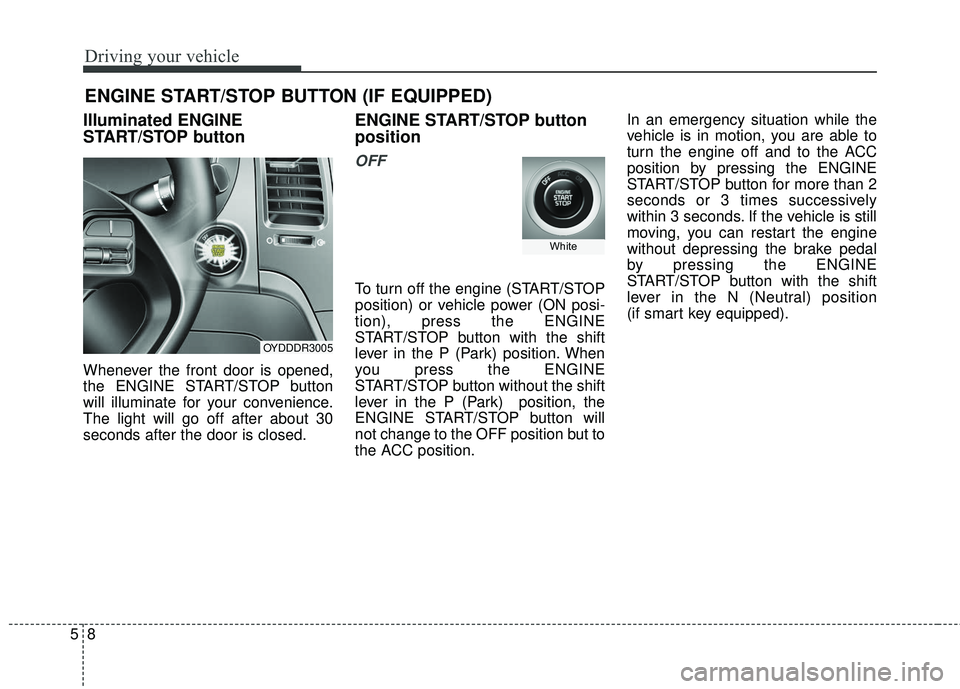
Driving your vehicle
85
Illuminated ENGINE
START/STOP button
Whenever the front door is opened,
the ENGINE START/STOP button
will illuminate for your convenience.
The light will go off after about 30
seconds after the door is closed.
ENGINE START/STOP button
position
OFF
To turn off the engine (START/STOP
position) or vehicle power (ON posi-
tion), press the ENGINE
START/STOP button with the shift
lever in the P (Park) position. When
you press the ENGINE
START/STOP button without the shift
lever in the P (Park) position, the
ENGINE START/STOP button will
not change to the OFF position but to
the ACC position.In an emergency situation while the
vehicle is in motion, you are able to
turn the engine off and to the ACC
position by pressing the ENGINE
START/STOP button for more than 2
seconds or 3 times successively
within 3 seconds. If the vehicle is still
moving, you can restart the engine
without depressing the brake pedal
by pressing the ENGINE
START/STOP button with the shift
lever in the N (Neutral) position
(if smart key equipped).
ENGINE START/STOP BUTTON (IF EQUIPPED)
OYDDDR3005
White
Page 350 of 584
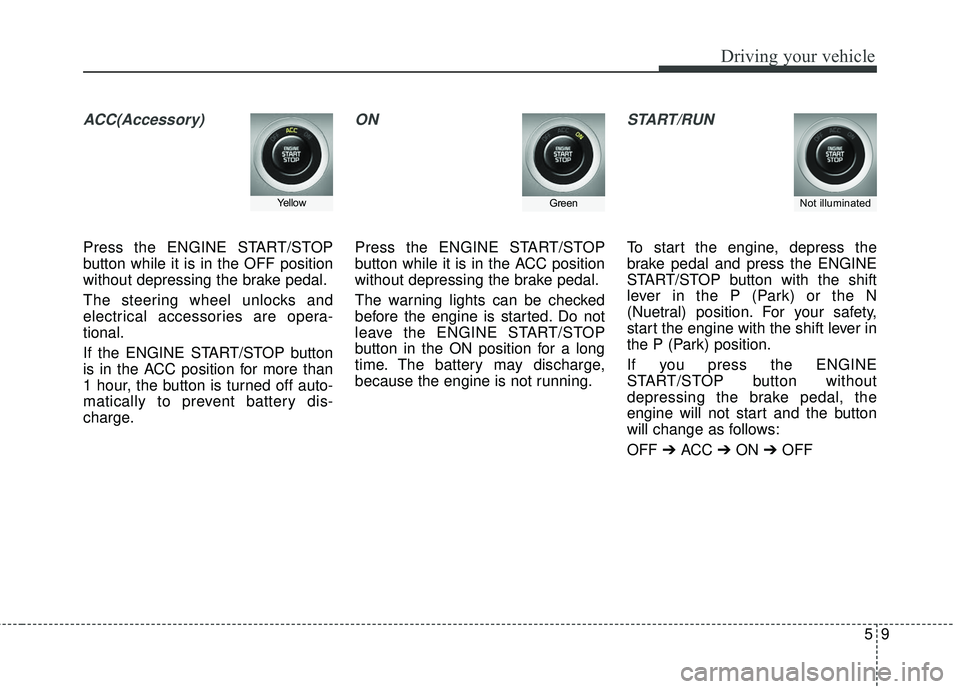
59
Driving your vehicle
ACC(Accessory)
Press the ENGINE START/STOP
button while it is in the OFF position
without depressing the brake pedal.
The steering wheel unlocks and
electrical accessories are opera-
tional.
If the ENGINE START/STOP button
is in the ACC position for more than
1 hour, the button is turned off auto-
matically to prevent battery dis-
charge.
ON
Press the ENGINE START/STOP
button while it is in the ACC position
without depressing the brake pedal.
The warning lights can be checked
before the engine is started. Do not
leave the ENGINE START/STOP
button in the ON position for a long
time. The battery may discharge,
because the engine is not running.
START/RUN
To start the engine, depress the
brake pedal and press the ENGINE
START/STOP button with the shift
lever in the P (Park) or the N
(Nuetral) position. For your safety,
start the engine with the shift lever in
the P (Park) position.
If you press the ENGINE
START/STOP button without
depressing the brake pedal, the
engine will not start and the button
will change as follows:
OFF ➔ ACC ➔ON ➔OFF
Not illuminated YellowGreen